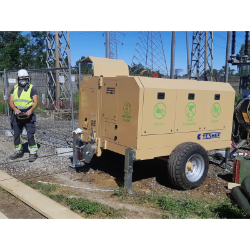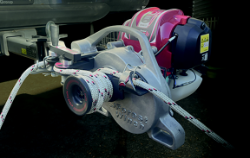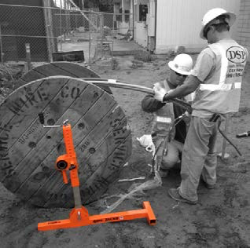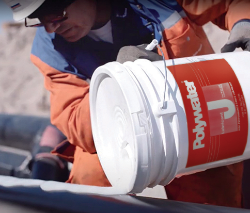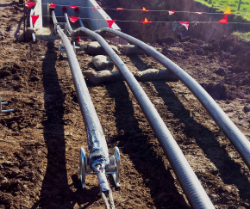Cable Hauling - Setting up for Success- Part 2
4 Jul, 2023
As discussed in Part 1, Cable hauling is a crucial part in the overall process of the installation and commissioning of communication, power, and utility cables. To ensure a smooth and efficient cable installation, it is essential to use the right tools and equipment that are fit for purpose. In this edition, we will discuss the benefits of utilising the most effective winch, cable drum stand, and the importance of cable pulling lubricant.
WINCHES
Winches are an essential tool in the cable pulling process, they come in all shapes and sizes, providing the cable installer an ability to pull cable from A to B. There are some key criteria in choosing a suitable cable winch to ensure the balance between capability and productivity. In the examples below we discuss the benefits and limitations of many of common winch types available on the market today.
ELECTRIC CAPSTAN WINCH - 240V
There are many different manufacturers of electric capstan winches, most of these will be a floor mount type and are used to pull cable on commercial and industrial projects. Pulling power from 1.36T through to 5.4T, the winches are generally a 240v plug into a power source or temporary power supply. The motor is small drawing only 10amps roughly, this translates to a slower pulling speed, broadly most will be 5 metres per minute or slower as the pulling load per unit goes up i.e., 4m/per min is up to 40% capacity and 2m/pm is from 40-60% of capacity and 1.5m/pm is for above 60% of capacity. The real benefit of this type of winch is that it is small and light weight and can be moved with ease around a project. They are great for short distance pulling operations, however they begin to lose efficiency as runs get longer. Another drawback is any operations over 60% are generally regulated by a duty cycle meaning that the unit must be allowed to cool for a period, and this can affect pulling for longer distances.
PETROL OR DIESEL-POWERED CAPSTAN WINCHES
These winches come in different configurations from 1T through to 10T and larger. The capstan winch has been adapted to suit many different industries, not just cable hauling. In the cable hauling space, a drive motor is connected to a capstan wheel via a hydraulic circuit and pulls the draw rope using the rotation of the wheel. Because of this, the engine needs to have the capacity to perform this direct pull, and this tends to impact the physical size, requiring a larger footprint to setup. This engine is normally required to power a hydraulic circuit and when run continuously can result in the duty cycle issue. The Hydraulic circuit should again be running at the 60% mark for normal operations, as using at a higher capacity over extended periods can lead to hot hydraulic circuits resulting in wear and tear issues. This type of winch is much heavier than the previous electric winch, however, they will have a faster pulling speed and can range from 10m/per min up to roughly 20m/per min. The rope is generally fed on to the ground or back into some type of storage container.
DRUM WINCH
Like the previous winch, the drum winch is normally petrol or diesel-powered and when drawing the rope back it feeds directly on to a drum. This drum is performing two operations, its pulling and storing the rope. This has some engineering calculation behind it as the winch drum can be affected by the size of pulling rope in ratio to the storage drum, incorrectly sized rope can collapse under the pulling weight. This also translates to a large engine required to power it, large drum to store the rope and therefore a larger physical footprint. This engine is required to power a hydraulic circuit. The Hydraulic circuit should be at the 60% for normal operations as using at higher capacity over extended periods can lead to hot hydraulic circuits. Pulling speeds are like that of the petrol- or diesel-powered winch also as they use a large engine, small engine drum winches are slower by nature of engine size/output.
BULL WHEEL WINCH
Bull wheel winches can range from 1T – 10T and above, they are available in traditional petrol or diesel engines. More recently battery electric winches have entered the market with similar capacities and specifications to that of traditional fuel powered machines. The bull wheel winch uses a multiple groove double capstan to pull the rope acting as a multiplier of the pulling load. This winch lends itself to smaller engines by nature of design, and therefore is also a smaller footprint. Manufacturers have also designed these with an area for storing the rope, creating an all-in-one compact unit. The pulling speeds are much higher as well with no load speeds of up to 65m/per min. There is bell a curve that represents the pulling speed vs the load, meaning that as the load increases the pulling speed decreases. The 60% capacity rule applies to these machines as well and for the petrol and diesel versions, these power a hydraulic circuit and encounters the same issues as previously mentioned around heating and wear. The Electric versions currently are a direct drive of the bull wheels and don’t have the hydraulic issues, however the battery power is tied to the pulling loads and using at higher loads will tend to drain the battery quicker. Cost sits at the medium to high range, however, the cost benefit analysis could identify this as a cost-effective unit, especially on larger runs and where petrol or diesel engines/generators cannot be used such as in tunnelling or underground operations.
CABLE DRUM STANDS
Utilising cable drum stands, or power assisted drum stands offers numerous benefits. Cable stands, such as A-Frame stands or vertical post stands, offer stability and support to cable drums, ensuring safe transportation and pulling. Drum jack stands, whether hydraulic or mechanical, facilitate controlled lifting and positioning of heavy cable drums, reducing the risk of injuries and strain on workers. Additionally, powered drum stands further enhance the process by enabling the controlled payout of cable, minimising tension, and the jerking effect during the cable pull. By utilising these stands, workers can optimise efficiency, enhance safety, and ensure smooth cable installation with reduced tension on the cable.
A-FRAME
A-Frame Stands feature a triangular or A-shaped structure that ensures stability and support for cable drums. While they provide excellent stability due to their structure, larger sizes may be less portable or require more effort to set up on-site compared to other options.
HYDRAULIC
Hydraulic Drum Jack Stands utilise hydraulic systems to lift and support cable drums, as well as assistance with the payout of cable, during the hauling process. With precise height adjustment and the ability to handle heavy cable drums, they are suitable for large-scale cable installation projects.
MECHANICAL
Mechanical Drum Jack Stands employ mechanical systems, such as ratchet or screw mechanisms, to lift and support cable drums. These stands are generally more compact and lighter weight than hydraulic ones, making them a good choice for smaller projects or confined spaces.
VERTICAL POST
Vertical Post Drum Jack Stands consist of a horizontal bar supported by two vertical posts. They allow the cable drum to rotate freely during the pulling process. These stands are simple, lightweight, and easy to transport.
Cable drum stand applications include Electrical utility distribution & transmission, construction and infrastructure projects and telecommunications installation.
CABLE LUBRICANT
Applying cable lubricant significantly reduces the Coefficient of Friction (CoF) acting on the cable and duct. Cable lubricant, also known as cable pulling lubricant or cable lube, is a crucial component in the cable installation process. In this guide, we will discuss the benefits of using cable lubricant during cable installation and share some best practices for its application.
BENEFITS OF USING CABLE LUBRICANT
Cable lubricant plays a crucial role in reducing friction between cables and conduit surfaces, facilitating the smooth pulling of cables through conduits, and minimising the force required for installation.
One of the key benefits of cable lubricant is its ability to prevent cable damage caused by abrasion, overheating, or stretching during the pulling process. By reducing friction, it safeguards the longevity and performance of the installed cables, ensuring they remain in optimal condition.
Cable lubricant also enables longer cable pulls, as it minimises the need for intermediate pulling points by lowering the overall force required to pull in a longer cable. This streamlined process enhances installation efficiency, saving time and effort.
CABLE LUBRICANT APPLICATION
Select a lubricant specifically designed for the type of cable and conduit material being used in your project, considering formulations tailored for specific cable jacket materials i.e HDPE, PVC, LSZH and those suitable for various conduit materials such as PVC or HDPE
Apply a generous amount of lubricant to the cable and conduit surfaces before and during the pulling process to effectively reduce friction and minimise cable damage. Reapplying along the run during long cable pulls may be necessary to maintain its effectiveness.
Planning your pull is a crucial step to ensuring the cable is installed correctly and safely. The use of the right, fit for purpose products provides benefits such as improving efficiency, reducing cable damage, ensuring smooth navigation through various installation environments, and enhancing overall safety. Ultimately this allows the installer to optimise the cable installation process, minimise potential issues, and ensure a reliable and long-lasting cable infrastructure. From Cable Tensions and Side Wall Pressure estimation software to all your cable installation tools, lubricants, sealants, and equipment, TEN Group has the knowledge and products to ensure your cables pulls are safe and successful.
Contact TEN: tengroup.com.au – sales@tengroup.com.au – 61 7 3212 8999
|



